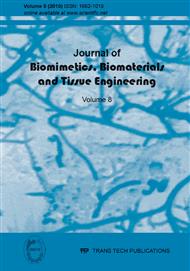[1]
J.Y. Lai, P.Y. Chang and J.N. Lin: J. Pediatr. Surg. Vol. 38 (2003), p.1752–55.
Google Scholar
[2]
A.B.Z. Zuki, Y.M. Hafeez, M.Y. Loqman, M.M. Noordin and Y. Norimah: Anat. Histol. Embryol. Vol. 36 (2007), p.349–56.
DOI: 10.1111/j.1439-0264.2007.00772.x
Google Scholar
[3]
K.P. Amid: Hernia Vol. 1 (1997), p.15–21.
Google Scholar
[4]
M. Decurtins and P. Buchman: Res. Exp. Med. Vol. 180 (1982), p.11–14.
Google Scholar
[5]
S. Kapan, M. Kapan, E. Goksoy, I. Karabicak and H. Oktar: Hernia Vol. 7 (2003), p.39–43.
DOI: 10.1007/s10029-002-0096-7
Google Scholar
[6]
C.Y. Wei, D.C. Chuang, H.C. Chen, C.H. Lin, S.S. Wong, F.C. Wei: Microsurgery Vol. 16 (1995), p.698–703.
Google Scholar
[7]
L.G. Griffith and G. Naughton: Science Vol. 295 (2002), p.1009–14.
Google Scholar
[8]
J.R. Fuchs, B.A. Nasseri and J.P. Vacanti: Ann. Thorac. Surg. Vol. 72 (2001), p.577– 90.
Google Scholar
[9]
E. Rabkin and F.J. Schoen: Cardiovasc. Pathol. Vol. 11 (2002), p.305–17.
Google Scholar
[10]
T. Ayele, A.B.Z. Zuki, B.M.A. Noorjahan and M.M. Noordin: J Mater Sci: Mater. Med. (2010), DOI 10. 1007/s10856-010-4007-7.
Google Scholar
[11]
M.L. Springer, T. Rando and H.M. Blau, in: Current Protocols in Human Genetics, edited by A.L. Boyle, Unit 13. 4, John Wiley & Sons, New York Publishers (1997).
Google Scholar
[12]
G.K. Pavlath, in: Methods in Molecular Medicine: Human Cell Culture Protocols, edited by G.E. Jones, Humana Press, Totowa (1996).
Google Scholar
[13]
A.K. Gangwar, A.K. Sharma, N. Kumar, N. Kumar, S.K. Maiti, O.P. Gupta, T.K. Goswami and R. Singh: J. S. Afr. Vet. Ass. Vol. 77 (2006), p.79–85.
DOI: 10.4102/jsava.v77i2.349
Google Scholar
[14]
S.D. Jenkins, T.W. Klamer, J.J. Parteka and R.E. Condon: Surgery Vol. 94 (1983), p.392–98.
Google Scholar
[15]
W.S. Tung, J. Zainol, A.G. Pilly, N. Yusof and L.M. Yusof: The Science Vol. 2 (2002), p.7–11.
Google Scholar
[16]
P.P. Parnigotto, P.G. Gamba, M.T. Conconi and P. Midrio: Urol. Res. Vol. 28 (2000), p.46–51.
Google Scholar
[17]
P.P. Parnigotto, M. Marzaro, T. Artusi, G. Perrino and M.T. Conconi: J. Pediatr. Surg. Vol. 35 (2000), p.1304–08.
Google Scholar
[18]
D.W. Hutmacher: J. Biomater. Sci. Polym. Ed. Vol. 12 (2001), p.107–24.
Google Scholar
[19]
S. Badylak, K. Kokini, B. Tullius, A. Simmons-Byrd and R. Morff: J. Surg. Res. Vol. 103 (2002), p.190–202.
DOI: 10.1006/jsre.2001.6349
Google Scholar
[20]
S. Chung, A. Hazen, J.P. Levine, G. Baux, W. A Olivier, H.T. Yee, M.S. Margiotta, N.S. Karp and G.C. Gurtner: Plast. Reconstr. Surg. Vol. 111 (2003), p.225–32.
DOI: 10.1097/00006534-200301000-00039
Google Scholar
[21]
I.A. Silver: Equine Vet. J. Vol. 14 (1982), p.7–15.
Google Scholar
[22]
D.O. Fauza, J.J. Marler, R. Koka, R.A. Forse, J.E. Mayer and J.P. Vacanti: J. Pediatr. Surg. Vol. 36 2001, p.146–51.
DOI: 10.1053/jpsu.2001.20034
Google Scholar
[23]
J. Singh, N. Kumar, A.K. Sharma, S.K. Maiti, T.K. Goswami and A.K. Sharma: Trends. Biomater. Artif. Organs. Vol. 22 (2008), p.34–44.
Google Scholar
[24]
P.G. Gamba, M.T. Conconi, R.L. Piccolo, G. Zara, R. Spinazzi and P.P. Parnigotto: J. Pediatr. Surg. Vol. 18 (2002), p.327–31.
Google Scholar
[25]
P.B. Van Wachem, L.A. Brouwer and M.J.A. van Luyn: Biomaterials Vol. 20 (1999), p.419–26.
Google Scholar
[26]
F.S. Kamelger, R. Marksteiner, E. Margreiter, G. Klima, G. Wechselberger, S. Hering and H. Piza: Biomaterials Vol. 25 (2004), p.1649–55.
DOI: 10.1016/s0142-9612(03)00520-9
Google Scholar
[27]
M.T. Conconi, P. D Coppi, S. Bellini, G. Zara, M. Sabatti, M. Marzaro, G. F Zanon, P. G Gamba, P. P Parnigotto and G. G Nussdorfe: Biomaterials Vol. 16 (2005), p.2567–74.
DOI: 10.1016/j.biomaterials.2004.07.035
Google Scholar


